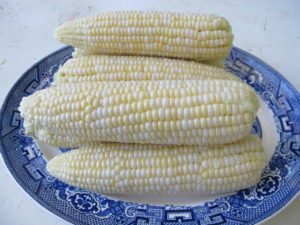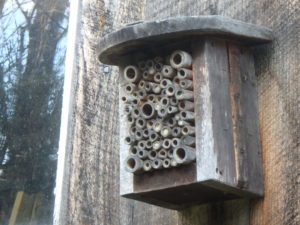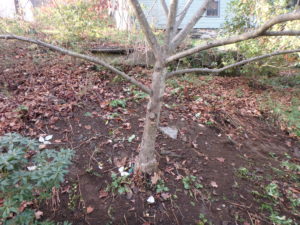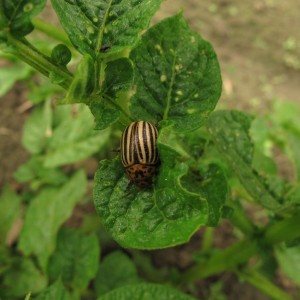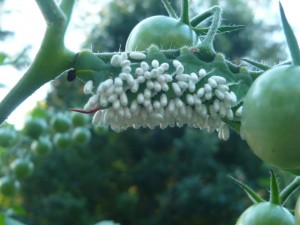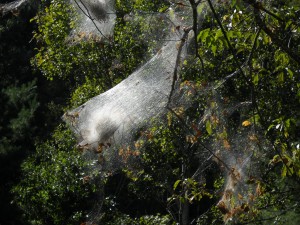How to Minimize Garden Pest and Disease Problems Next Year
As an organic gardener, I am always looking for ways to minimize the chances of pests or diseases in my garden. I don’t use fungicides or insecticides, even those that are all-natural and are approved for use by organic farmers and gardeners. I want it all: tasty veggies and healthy plants – but no interventions. And generally, I get that.
How do I avoid pests and diseases? Give plants what they need for optimal growth. Plants growing in great soil with appropriate amounts of sun and moisture are generally healthy plants. It has been scientifically proven that healthy plants are less attractive to pests and diseases.
A corn plant that is pumped up with chemical fertilizer, for example, is more attractive to corn borers than one has been raised organically and had its soil amended with manure.
I attended a lecture by Dr. Larry Phelan of Ohio State University in which he presented results of trials comparing conventional corn with organic corn. His data was convincing. Yes, chemical fertilizers can produce big yields, but excess nitrogen from chemical fertilizers will attract borers.
Then there is the problem of tomato hornworms. These nasty, aggressive critters are a real problem for some gardeners, but I have not seen one in my tomato patch in years. Why? I’m not sure, but the last time I saw one, it was being parasitized by small wasps.
If you see what look like grains of rice on a tomato hornworm, they are being attacked by a braconid wasp. The “rice” grains are larvae that are slowly sucking the hornworm dry. If you see this happening, don’t kill the hornworm. Just remove it (wearing gloves) and carry it far from the tomatoes. The larvae will do the rest.
How can you encourage parasitic wasps to live in your garden? First, do not kill them – though they are not very noticeable. And do not use chemicals to kill other pests such as Japanese beetles or potato bugs.
I have a small “home” for solitary wasps attached to my barn. It is a box filled with bamboo tubes of different sizes, their ends facing out. These tubes offer shelter for insects and places where they can lay eggs or stay out of danger. I don’t see it used much, but I know that solitary wasps do need such places. Nature offers the best places, I’m sure, so if I don’t rake and manicure every inch of my property. A naturalistic setting offers many sites for good bugs. Mother Nature, left to her own devices, tends to have a balance of good critters and bad. I try not to second guess her too often.
But what about introduced species that are a problem with our crops? They can easily cause damage and get out of control. One such pest is the spotted winged drosophila (SWD), an Asian fruit fly that arrived in 2011. Instead of just eating overly ripe fruit laying on the ground (as most native species do), this one will attack good fruit on the bush. Mushy fruit (complete with bugs) is the result. Blueberries have been severely affected in some places.
I recently phoned Dr. Alan Eaton, the state entomologist for New Hampshire, to see if any progress has been made in controlling this pest. No, he explained, they are still in the learning phase at present. Early reports had suggested that early-ripening crops of blueberries and strawberries were less susceptible to SWD. But he told me that this year they were finding earlier and earlier reports of damage. And this year they had reports of SWD on cherries for the first time.
These fruit pests are just one twelfth of an inch in size, so netting (always a friend to organic gardeners) musts be very fine to keep them off our crops. Most commercial growers are resorting to chemical sprays. Me? I’m rooting for the birds and other insects to take charge.
So what can you do to reduce chances of pest and disease problems next year? Clean up your garden well this fall. Apple scab, for example, causes deformed, inedible fruit. The disease can be minimized by simply raking up leaves and fruit- right now. This year I took it a step farther and used a pole to knock off any apples left on the tree, and raked them up, too. Many of those left on the tree were clearly rotten. I’ve read that spreading compost under apple trees introduces beneficial microorganisms and may help control diseases, too.
According to Dr. Eaton, destroying vines and leaves of plants in the squash family – cucumbers, squash, pumpkins, melons etc. – is important at this time of year. Striped cucumber beetles over-winter in plant debris, so getting your garden clean is important. I put vine and tomato plants on my brush pile and burn it once snow has fallen, but you can also bag it and send it off with household trash. Composting is not usually an effective way of ridding your garden of these pests.
Remember: well-tended plants are less susceptible to diseases and less attractive to pests. I am always amazed at how healthy my garden is despite – or because – I use no chemicals – and have always used organic methods. It takes a while to develop a good supply of beneficial insects, I suppose, but get started!
Henry is a UNH Master Gardener and the author of 4 gardening books. He is available to give talks at garden clubs and libraries. Reach him at henry.homeyer@comcast.net or P.O. Box 364, Cornish Flat, NH 03746.
Good Bugs, Bad Bugs
Many gardeners seem to think that any UFI (Unidentified Flying Insect) is a potential threat to their tomatoes or the spinach. When in doubt, they swat it, squish it or submerge it. But most bugs are not bad – and many are helpful.
We all know that lady bugs are good. They eat aphids and in fact, some enterprising businesses are selling lady bugs by the thousand. My advice? Don’t bother buying them. If you’re not spraying your flowers and vegetables with insecticides, you will naturally have some ladybugs and other aphid eaters. Of course insecticides will throw off the balance of nature, and the pests may dominate. But a good healthy garden should attract beneficials like ladybugs in the quantities that you need. Bring in a thousand? They might fly away the same day.
According to the lovely little guide book, Good Bug Bad Bug: Who’s Who, What They Do, and How to Manage Them Organically by Jessica Walliser, a ladybug can eat up to 5,000 aphids in its lifetime. But there are plenty of other good bugs. This book, by the way, is simple, well illustrated and sturdy enough to take to the garden. I recommend it.
The assassin bug is just that: a voracious predator that will eat cabbage worms, potato beetles, cucumber beetles, cutworms, earwigs, Japanese beetles, Bean beetles, tomato hornworms, and more. They are generally black, and about half an inch long with a broad body and bristly front legs. They have a sharp curved beak they use to penetrate other insects, allowing them to inject a poison to kill them and turn their insides into a “smoothie” they can drink. They can sometimes pierce human flesh if handled roughly.
Lacewings are beautiful green flying insects with diaphanous wings. You’ve probably seen them on your window screens, attracted to the lights – they’re about an inch long. But it is their larvae that do they work in the garden – they eat about 100 aphids a day! The larvae are brown and white with big mandibles for grasping prey. They are half an inch long, and fast moving. The adults eat nectar and pollen of flowers and weeds including dandelions, Queen Anne’s lace and goldenrod so a few weeds are good to have – alonmg with plenty of flowers.
Parasitic wasps are generally small – from 1/32 of an inch to half an inch – but do great work. There are some 200 different kinds, according to Good Bug Bad Bug. Many have noticeable ovipositors for laying eggs, but don’t be confused and think they are stingers – these beneficial insects do not sting. They generally lay their eggs in the bodies, larvae or eggs of other insects. Once their eggs hatch, the young parasitic wasps feed on their prey.
One type of parasitic wasp feeds on the tomato hornworm. If you see small white “grains of rice” on the back of a hornworm, these are actually larvae of a wasp. Don’t kill the hornworm! Just move it off, away from your tomatoes, and let the wasp larvae do their thing. Like the lacewings, the adults feed on nectar and pollen, so a diverse garden with continuous blooms is a good attractant.
One of the things I like about the book Good Bug Bad Bug is that it offers many solutions to an insect problem. Row cover, a breathable spun fabric, is offered as a solution to striped cucumber beetles, and it reminds the reader that cukes are insect pollinated so you can’t keep it on once your vines start to produce blossoms. The book also suggests interplanting with marigolds, catnip or tansy or putting out yellow sticky cards to catch the culprits. Mulch, the book says, will help keep females from contact with the soil where they lay their eggs, too. I didn’t know that.
Potato bugs are my current nemesis. I plant my potatoes much later than my neighbors (in late June) which often means the bugs are already busy by the time my spuds come along. This year they have found me anyway. Every day I go down the row of potatoes, flipping the foliage over to look for adults and orange egg masses underneath the leaves. If I spot eggs, I remove that part of the leaf and put it in soapy water. This sounds tedious, but is actually just a 5 minute job for my 65 plants – and it makes a huge difference.
Diligence counts: I skipped a couple of days of patrol, and found potato bug larvae eating my plants. And picking 50 larvae is a lot more work than removing one leaf. So I shall keep up my vigilance. And if the larvae seem to be winning, I can always spray a biological control called Bt. This is a bacterium that will control them, but damage nothing else. But not all Bt is the same: ask for one that controls potato beetles (San Diego or tenebrionis).
Try to get over your aversion to bugs in the garden, if you have one. Just because a bug is unknown to you is no reason to squish it. It may be an assassin bug, ready to help you!
Henry Homeyer is the author of 4 gardening books. His Web site is www.Gardening-Guy.com. He is also a garden designer, gardening coach and public speaker.
Tomato Hornworms and Other Late Summer Pests
Sometimes it’s easy to get discouraged about the garden: Early in the spring there are seeds that don’t germinate well in cold, wet soil. Then the weeds germinate too well and try to take over the garden when things warm up. Next Colorado potato beetles attack the potatoes. By mid-summer early blight and other diseases start killing leaves and slowing growth on tomatoes, and now the tomato hornworms come along to browse the tomatoes and their vines. Gee whiz, is there no mercy for gardeners? I thought gardening was supposed to be easy!
But there is some good news. Mother Nature is doing her best to control some pests, tomato hornworms among them. Tomato hornworms are green larvae that get huge (up to 3-5 inches long), and have voracious appetites. Bad infestations can defoliate tomato plants in just a day or two. Because of their green color and markings, they are often very hard to notice, too. This year they seem worse than normal, according to some of my readers – though not in my garden. This is the season when they are most prevalent.
If you seen a tomato hornworm with little white attachments something like small grains of uncooked rice, do not kill the hornworm as it is being attacked by the larvae of a parasitic wasp. These white projections are cocoons containing the pupae of a braconid wasp. They indicate that the good bugs have found the bad bugs, and will destroy them.
I watched a hornworm that was covered with these tiny white cocoons, and over a 24 hour period it ate nothing. It was slowly dying, and appeared to have no appetite. I called Dr. Alan Eaton, NH State Entomologist, who told me that the wasps kill their prey slowly, allowing the larvae to feed long enough to develop. At a certain point, he said, the hornworms stop feeding. When he encounters a hornworm with parasitic wasp cocoons, he takes no chances – he moves it to another location away from his tomatoes where the braconid wasps can develop.
If you’ve seen a moth that resembles a hummingbird, that is the adult form of the tomato hornworm. According to Dr. Eaton, an adult moth of the tomato hornworm is about the same size as a ruby throated hummingbird. They are very strong fliers, and actually overwinter in the places where they can survive without freezing. Then they fly north in the spring, finding new feeding and mating territories.
One last hornworm tidbit: according to Dr. Eaton, there are 2 species, the tomato hornworm and the tobacco hornworm, and the tobacco hornworm is much more prevalent. So if you have been cussing out those nasty tomato hornworms, maybe they’re laughing and saying, “We’re actually tobacco hornworms!”
According to Dr. Eaton – and several readers who have sent me questions – this is a bad year for green stinkbugs. These triangular-shaped green bugs are feeding on everything from grasses and veggies to peaches and apples. Perhaps the mild winter resulted in higher numbers of them. They stink if crushed, so Dr. Eaton recommends picking them and dropping them into soapy water. The brown marmorated stinkbug is often a pest, but the green one is not usually as prevalent as it is this year.
This is also the season that fall webworms appear. You may call them tent caterpillars, but they are of a different species of pest. The tent caterpillars form webs, or tents in crotches of trees early in the summer, but the webworms create their nests near the tips of branches now, and into the fall. With time, the nests get bigger, enclosing more and more leaves as they grow. If the tent is down low you can physically remove the teeming mass of caterpillars by clipping off the branch and dropping it into a bucket of soapy water.
If the fall webworms are close enough to the ground that you can spray the leaves near them, you can apply a biological control. There is a product called Dipel, which contains a bacterium (Bt kurstaki) that will kill the worms if they eat leaves sprayed with it. This bacterium will not hurt us, our pets, fish or birds. It is specific to caterpillars. And Dipel lasts for years in the container, so you can invest in a package of it and know that it will be good in the future.
I understand the urge to “nuke” the bad bugs. Hornworms eating my tomatoes? Nuke ‘em. But I don’t. And since I let the braconid wasps feed on the hornworms years ago, I rarely see one of those bad boys. Chemical pesticides change the garden environment. It may please you in the short run, but in the long run, let Mother Nature – and your fingers – take control. Pick’em, don’t nuke ‘em.
Henry Homeyer’s new children’s book, a fantasy-adventure for 8-12 year-olds called Wobar and the Quest for the Magic Calumet, is coming out in October. His Web site is www.Gardening-Guy.com; his e-mail is henry.homeyer@comcast.net.



